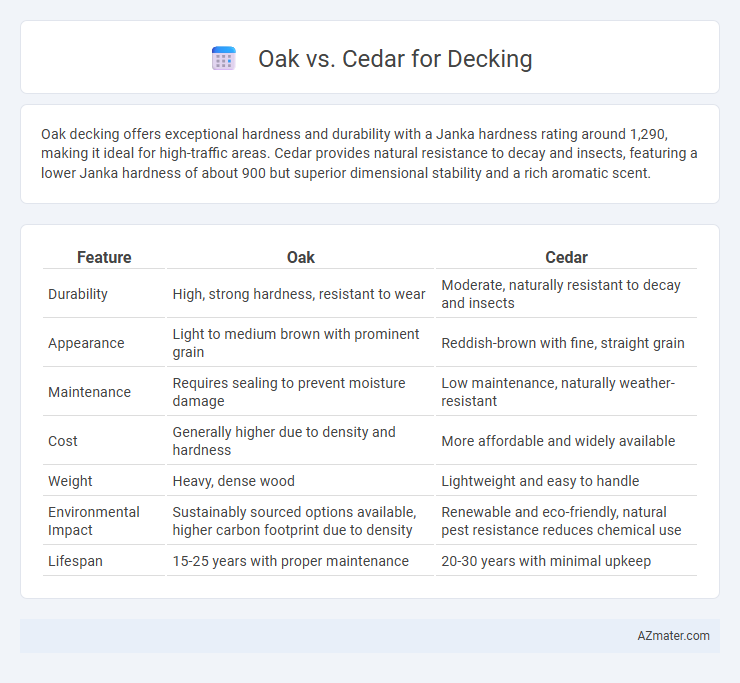Oak decking offers exceptional hardness and durability with a Janka hardness rating around 1,290, making it ideal for high-traffic areas. Cedar provides natural resistance to decay and insects, featuring a lower Janka hardness of about 900 but superior dimensional stability and a rich aromatic scent.
Table of Comparison
| Feature | Oak | Cedar |
|---|---|---|
| Durability | High, strong hardness, resistant to wear | Moderate, naturally resistant to decay and insects |
| Appearance | Light to medium brown with prominent grain | Reddish-brown with fine, straight grain |
| Maintenance | Requires sealing to prevent moisture damage | Low maintenance, naturally weather-resistant |
| Cost | Generally higher due to density and hardness | More affordable and widely available |
| Weight | Heavy, dense wood | Lightweight and easy to handle |
| Environmental Impact | Sustainably sourced options available, higher carbon footprint due to density | Renewable and eco-friendly, natural pest resistance reduces chemical use |
| Lifespan | 15-25 years with proper maintenance | 20-30 years with minimal upkeep |
Introduction: Oak vs Cedar Decking
Oak and cedar are popular choices for decking, each offering distinct characteristics. Oak is known for its strength, durability, and dense grain, making it resistant to wear and heavy foot traffic. Cedar provides natural resistance to decay and insects, with a lighter weight and appealing aroma, ideal for outdoor environments where longevity and aesthetics matter.
Durability Comparison: Oak and Cedar
Oak decking offers exceptional durability due to its dense hardwood structure, making it highly resistant to wear, dents, and moisture damage over time. Cedar, while softer and less dense than oak, provides natural resistance to rot, decay, and insect infestations, making it durable in outdoor environments but more prone to surface wear. Both woods benefit from proper sealing and maintenance, but oak typically outperforms cedar in longevity under heavy traffic and harsh weather conditions.
Weather Resistance of Oak and Cedar
Oak decking offers exceptional weather resistance due to its dense grain structure and natural tannins that protect against moisture absorption and decay, making it highly durable in varying climates. Cedar is renowned for its excellent resistance to rot and insect damage, attributed to natural oils that help it withstand wet and humid conditions without warping or splitting. Both woods provide durable options for outdoor decking, but cedar's lighter weight and natural oils offer superior resistance in consistently damp environments compared to oak.
Longevity and Maintenance Needs
Oak decking offers exceptional durability with high resistance to wear, making it ideal for long-term use in outdoor environments, though it requires regular sealing to prevent moisture damage and warping. Cedar decking is naturally resistant to decay, insects, and rot, reducing the need for chemical treatments, but it tends to soften and weather faster than oak, necessitating more frequent maintenance like staining or sealing. Both woods provide excellent longevity; oak demands more intensive upkeep to maintain its structural integrity, while cedar offers lower maintenance with a more natural aging process.
Cost Analysis: Oak vs Cedar Decking
Oak decking typically costs more per board foot than cedar due to its density and durability, with prices ranging from $5 to $7 compared to cedar's $3 to $5. Cedar offers natural resistance to rot and insects at a lower upfront cost, reducing initial investment for budget-conscious projects. Despite higher material costs, oak's longer lifespan and greater strength can result in lower maintenance expenses over time, influencing overall cost-effectiveness in deck construction.
Visual Appeal and Color Choices
Oak decking boasts a classic, warm appearance with light to medium brown tones that age gracefully into a silvery-gray patina, enhancing outdoor spaces with timeless elegance. Cedar offers rich reddish hues and natural variations in color, ranging from amber to deep brown, providing a vibrant and distinctive visual appeal. Both woods develop beautiful weathered finishes, but cedar's inherent color diversity often creates a more dynamic and rustic aesthetic for decks.
Workability and Installation
Oak offers excellent workability with its dense, hard grain, allowing for precise cuts and durable fastening, though it may require pre-drilling to prevent splitting. Cedar is prized for its lightweight nature and straight grain, which simplifies installation and reduces the effort needed for handling and fastening. Both woods respond well to common woodworking tools, but cedar's natural resistance to warping enhances ease of long-term maintenance during installation.
Environmental Impact and Sustainability
Oak decking offers durability with moderate environmental impact due to its slower growth rate and higher resource demands, while cedar is prized for its natural resistance to decay and pests, promoting longer lifespan and reduced chemical treatments. Cedar's faster growth and renewable forestry practices contribute to better sustainability, making it a more eco-friendly choice for decking. Both woods require responsible sourcing certifications like FSC to ensure minimal ecological footprint.
Common Issues and Solutions
Oak decking often faces issues with moisture retention leading to warping and rot, requiring sealing treatments and proper drainage systems to maintain durability. Cedar is prone to fading and surface checking but benefits from natural oils that resist decay, and periodic staining or sealing can preserve its appearance and structural integrity. Both woods need regular maintenance schedules including cleaning, sanding, and resealing to address common weathering problems and extend deck lifespan.
Best Applications and Recommendations
Oak offers exceptional strength and durability, making it ideal for high-traffic decking areas that require long-lasting performance and resistance to wear. Cedar excels in natural resistance to decay and insects, providing a lightweight option perfect for shaded or moist environments where rot prevention is critical. For cost-effectiveness and aesthetic appeal, cedar is recommended for residential decks with moderate use, while oak suits commercial or heavily used outdoor spaces demanding superior hardness.

Infographic: Oak vs Cedar for Decking
 azmater.com
azmater.com